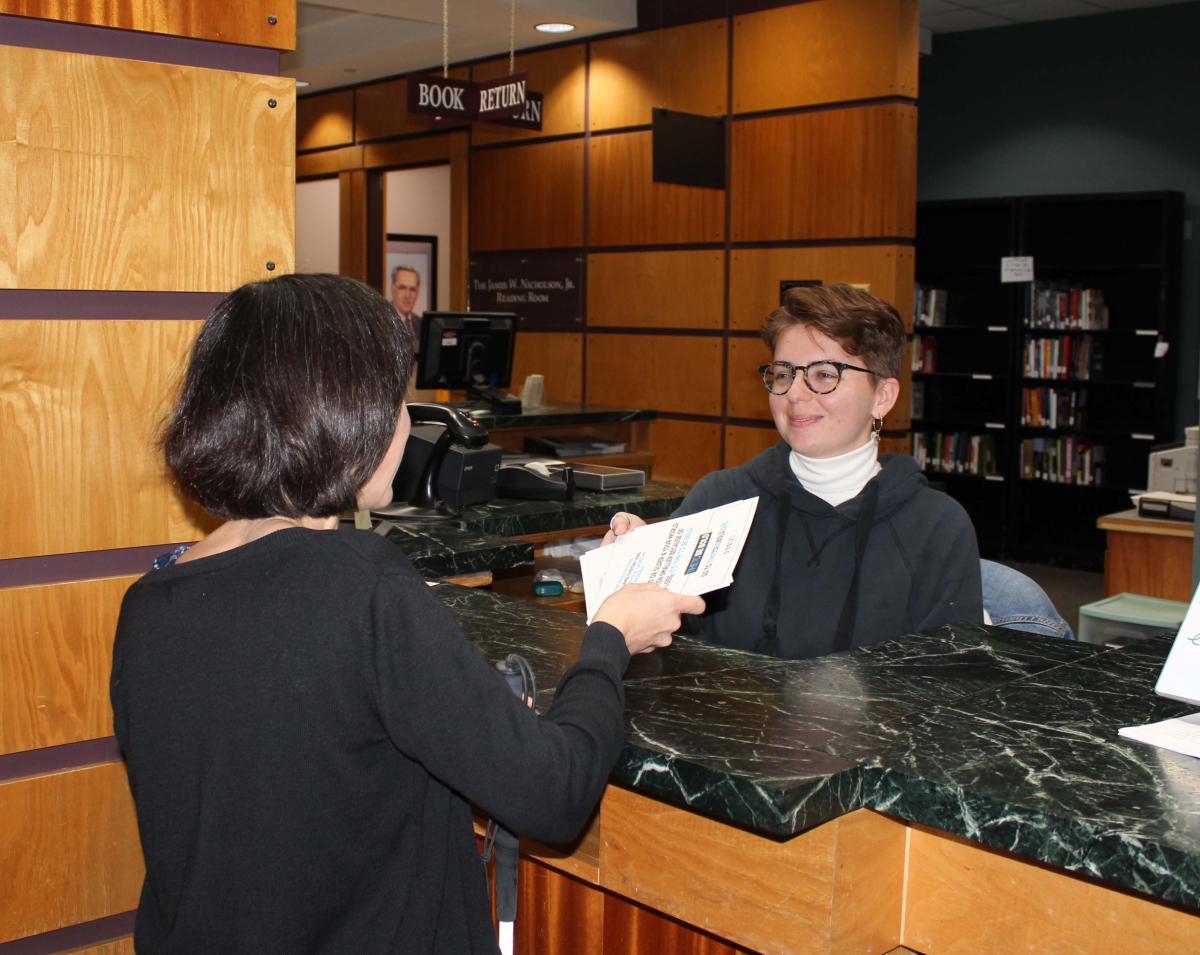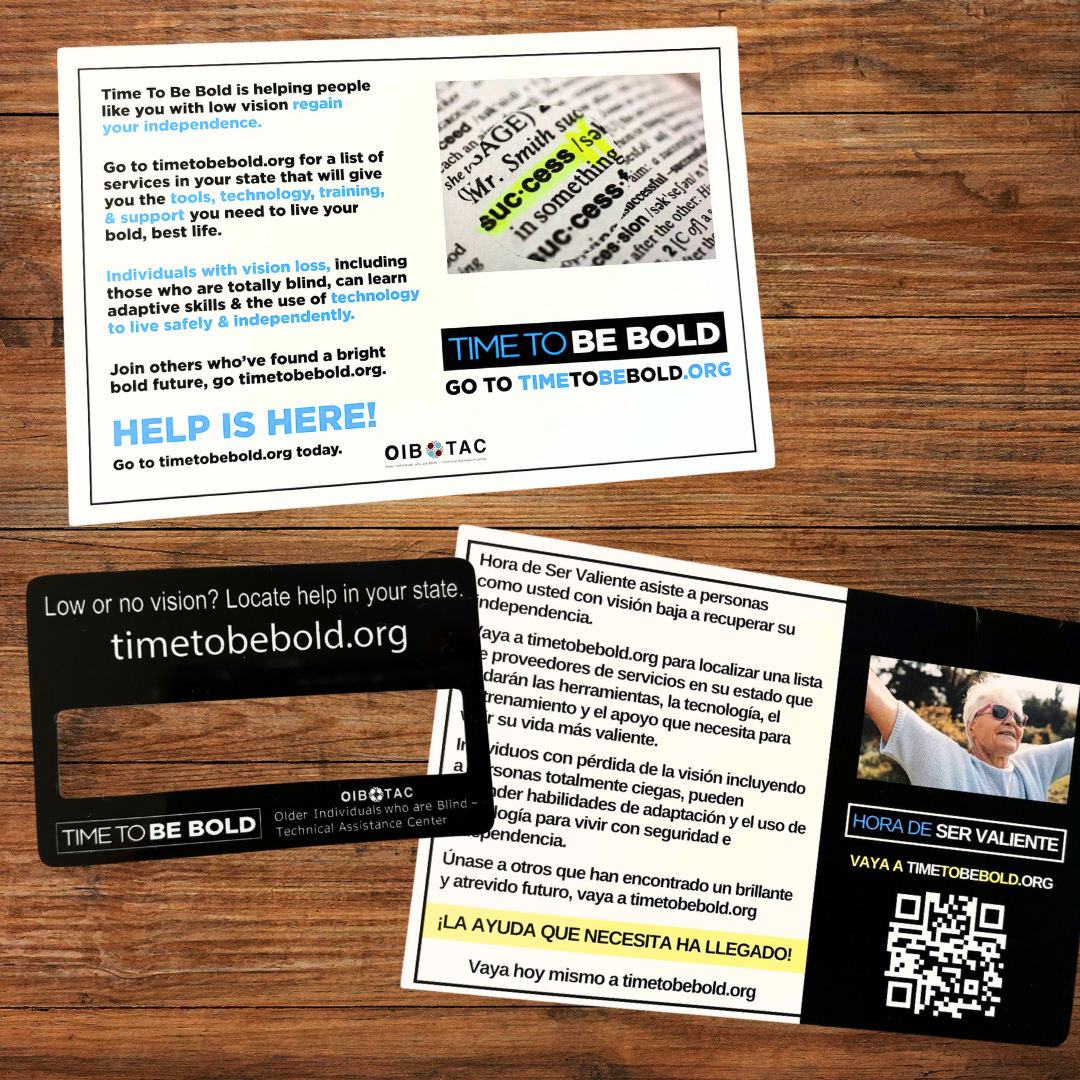Community Outreach
Community Outreach
Build collaborations within the community to raise awareness of your services, increase referrals, attract new volunteers, and further the mission of promoting independence for people with vision loss.


Partner with the Time To Be Bold Campaign
Help raise awareness of services for older blind in your state by promoting the Time to Be Bold website.
Share our video about services from our YouTube channel.

Contact info@oib-tac.org to...
- Distribute a shareable version of the Time To Be Bold commercial for use by your local TV and radio stations.
-
Request Time to Be Bold promotional materials to distribute to community partners.
- Change any program contact information on TimeToBeBold.org/Find Services to help new referrals find OIB services quickly in your state.
Contact OIB-TAC State Directory Time To Be Bold State Directory
Best Practices
The state OIB program will have a clearly defined plan and policy concerning statewide outreach activities so that the agency’s purpose, eligibility criteria, and information about accessing services can be shared. The outreach plan will include contact with the medical community, specify the types of activities the OIB staff are required to complete, and include provisions for providing education/training about blindness and low vision to community partners who may assist consumers in community integration.
Agencies will have a community outreach packet or toolkit with appropriate information and resources. Community outreach training will be tailored to the occasion and organization and will encourage community support for older people with visual impairments. Outreach will include multiple formats, such as pamphlets, flyers, presentations, press releases, public service announcements, and consistent use of social media/internet resources. Staff will explore and access opportunities to publicize the program and recruit potential consumers. Outreach materials will be culturally sensitive, accessible, and in appropriate languages.
Acceptable Practices
Any agency that does not implement best practices will have a plan in place to move toward best practices that includes an expeditious timetable and benchmarks.
While moving toward best practices, place priority on generating referrals and developing outreach materials.
Unacceptable Practices
It is unacceptable to do no or minimal community outreach or to expect staff to do community outreach without adequate training and resources.
Clarifying Comments
OIB programs will use multiple, innovative strategies to facilitate community outreach. Potential strategies may include staff mentoring staff in conducting community outreach activities, using social media, networking with other organizations, submitting to newsletters of other organizations, exhibiting at health fairs and community festivals, etc.
Many resources are available to develop community outreach materials, including the OIB Technical Assistance Center (www.oib-tac.org). The Center for Disease Control (CDC) has an interactive web application that provides health information by county that may be helpful in developing outreach materials (wwwn.cdc.gov/communityhealth).
Suggested Presentation Topics for Community Outreach
- Educating about the basics of blindness and low vision. Training about how to work with people with visual impairment, including walking with someone with a visual impairment (human guide).
- Introducing the purpose of the OIB program and how to refer potential users.
- Integrate people with vision impairment into the community and educating about the importance of full inclusion.
- Explaining how older persons with visual impairments can achieve independence.
- Introducing strategies for making an environment accessible and welcoming to persons with visual impairments, including cost effective environmental modifications.
- Avoiding and preventing falls and instructing other caregivers or professionals about this issue.
- Integrating OIB programs with other programs/services that target older adults (e.g., senior centers).
Resources
Sample handout for doctors to increase referrals to OIB services
Hints for Knowing if a Patient is Eligible for Services at the Blind Association
1. Patient can not read appointment card.
How to help: Use a black felt tip pen to write the appointment date and time larger.
2. Patient can not see where to sign their name.
How to help: Use a credit card or other piece of paper to underscore the line where they need to sign or make the line darker with a black felt tip pen.
3. Patient is unable to read directions on the prescription bottle or information about their physical condition.
How to help: Write information larger with a black felt tip pen or enlarge with a photocopier.
4. Patient can not get to appointments because they cannot drive anymore.
How to help: Refer to Susquehanna Association for the Blind 274-6711 or COLT.
5. Patient has difficulty filling out a check or identifying money when paying for visit.
How to help: If the person is comfortable, help them fill out the check. For a long-term solution refer to the Susquehanna Association for the Blind.
6. Patient complains of not being able to read their watch or calendar.
How to help: Send them to Radio Shack for a talking watch.
7. Patient has difficulty finding the door handle or knowing where steps begin or end.
How to help: Use verbal instructions or sighted guide. A long-term solution is to place contrasting colored tape on the first and last step.
8. Patient appears to be hesitant when entering a room that is a lot brighter or dimmer than the room they came from.
How to help: Allow the person time to adjust.
Sample Form for Doctor Referral to Vision Services (Minnesota)
Sample Outreach Letter
State Organization
Address
Date
Recipient’s name
Organization
Dear Recipient,
The Commission for the Blind has tasked me with providing in-service training and outreach on aging and blindness. Eight of ten among those who are legally blind are 55 or over. The Commission is committed to assisting individuals with vision loss to achieve their maximum potential and independent living goals.
I can provide free information sessions for groups of seniors, a table at a health fair, or provide assistance in forming a low vision support group. The Commission encourages me to travel around the state, spreading the word about the services and support available to elders who are losing their vision.
My presentation lasts for approximately one hour and covers the following topics:
- Normal changes in vision associated with aging
- Major causes of vision loss for seniors (macular degeneration, glaucoma, cataracts, diabetic eye disease)
- What you can do to preserve your vision
- Low vision services of the Commission and other agencies
- low vision aids and assistive devices
- How best to assist blind people in your community
The topic is interesting, the message is positive, and the devices are nifty. If you are interested, please call me or email. I look forward to hearing from you.
Sincerely,
Name and contact information
Sample Outreach Letter to Church or Faith-based Organization
Dear [NAME]
Are there Seniors in your congregation who no longer come to church, or have pulled away from activities they once enjoyed doing? They may be having difficulties due to low vision.
Hello, my name is [NAME] and I work at [Vision Loss Resources]. We are a non-profit working with Seniors who have low vision due to macular degeneration, glaucoma, cataracts or other causes of vision loss. We have been helping people for over 100 years and we are committed to reaching those seniors who may not know about our services and community.
Vision changes can lead to depression and feeling of loss. Without support vision changes can often result in safety concerns and withdrawal. Even with a diagnosis from an eye doctor, appropriate help is generally not available in the medical system because vision rehabilitation and support are not covered by medical insurance,
Our program connects seniors to the resources, equipment, training, and support they need as their vision changes. We offer presentations to help seniors and their caregivers learn more about symptoms of age-related eye diseases and the services we can offer at no cost to help maintain or re-gain independence.
If you feel like we would be a resource for your congregation, I would be happy to present to your Seniors and your ministry teams that support Seniors. Please feel free to contact me directly at [phone] or [email].
Warm Regards,
[NAME]
[Title]
Sample Flyer to Solicit Community Presentation
Commission for the Blind
Name of older blind program
Public Education Program
The (state) Commission for the Blind has staff available to provide in-service training and outreach on aging and blindness. We can tailor a training program to the needs of your group. There is no charge for this service.
Audiences:
- Low vision support groups
- Councils on aging
- Assisted living facilities
- Nursing homes
- Health or community resource fairs
- Home health care agencies
Topics:
- Definition of legal blindness and legal benefits
- Causes of blindness among the elderly
- Services of the Commission for the Blind (older blind program)
- Popular misconceptions about blindness
- Suggestions on how to assist blind people
- Low vision aids
- Proper technique for being a “sighted guide”
- Information about other services, such as:
- The Braille and Talking Book Library
- Talking Information Center
Contact:
Name
Name of older blind program
Organization
Address
Phone
Sample Outline for In-Service to Community Partners
It is helpful to include an outline of In-service training agendas when reaching out to various community audiences.
Audiences and Goals
Audiences
- Nursing home staff (CNAs, dietary workers, MSWs)
- Home health aides, home care workers, visiting nurses
- Staff at assisted living facilities, councils on aging
Goals
- Provide accurate info about low vision and blindness
- Enhance sensitivity to vision loss
- Discuss benefits and services
- Demonstrate low vision aids
- Present guidelines and etiquette for helping people with low vision
- Teach human guide techniques
- Decrease stigma of blindness
- Stress independence through support
In-service Topics
Normal Vision Changes Associated with Aging
- Presbyopia, increasing far-sightedness
- Need for more light, reduced color perception
- Longer adaptation to darkness or bright sunlight
- Causes of vision loss (risk factors, functional vision, treatment). Use NEI photographs. Most legally blind people have some usable vision.
- Macular degeneration (including phantom vision)
- Glaucoma
- Cataracts
- Diabetic eye disease
How do you recognize vision loss?
- Bumping into objects
- Moving hesitantly or next to the wall, tripping
- Squinting or tilting the head to see
- Requesting additional or different lighting
- Holding reading material close to the face
- Reaching for one thing and hitting something else
Act quickly in eye emergencies!
- Sudden change in vision with or without pain
- Sudden increase in floaters and/or flashing lights
- Sudden partial loss of vision
Definition of Legal Blindness and Other Legal Matters
- How to register for benefits
- Real estate, personal, and excise taxes
- Parking permit
- White Cane Law
- Bioptic driving regulations in the state
Description of Services
- Social work/Adjustment counseling services/support groups
- Independent Daily Living/Vision Rehabilitation Therapy
- Low vision services
- Other services e.g. Braille and Talking Book Library
- Orientation and Mobility
Low Vision Aids Demonstration and Information on How to Acquire Devices
- Magnifiers
- Labeling using contrast and texture
- Talking watch, keychain, calculator, large print kitchen timer, address book, cards, Bingo
- 20/20 pens, large print paper
Guidelines and Etiquette for Working with Blind People
- Talk directly to the individual.
- Greet a blind person with your name.
- Announce that you are leaving.
- Be aware of safety, lighting and contrast.
- Use vision words like “see you later.”
- Provide descriptions. Do not say, “The restrooms are over there.”
- Ask questions, “How can I help you?”
- Do not move things without explanation.
- When serving food, use contrast, lighting, and description, for example, clock method.
Human Guide
- Demonstration and short practice session of basic grip, stance, narrow spaces, and seating (as time allows)
Psychological Impact of Vision Loss
- Blindness as multiple losses
- Possible depression, anxiety, anger, disorientation, fear of isolation and dependence
- Adjustment issues
- Effect of dementia on vision and vision on dementia
Conclusion
People with vision loss can continue to be vital members of the community and enjoy life in many ways. You can be a part of that process with your awareness of resources, your willingness to keep communication open, and your encouragement and support.
Sample True or False Quiz to raise awareness about vision loss.
Confront stereotypes, raise awareness of facts, and educate the public about blindness and low vision through fun quizzes that will grab the crowd's attention.
True False Quiz
1. If a person is legally blind they have no usable vision.
2. Magnifiers are good for reading long novels.
3. It is possible for a person who is legally blind and uses a support cane to cross a busy intersection safely.
4. A person who is vision impaired could prepare a breakfast of eggs and pancakes.
5. Low vision can be corrected with glasses.
6. A person who is blind can use a computer.
7. It is impossible for a person who is blind to dial the telephone independently.
8. A person who is vision impaired has better hearing than normal.
9. The white cane law states that all people who are legally blind must use a white cane for identification.
10. Most vision loss is age related.
11. When a person is diagnosed as being legally blind they no longer need to visit the eye doctor.
12. Individuals who are totally blind are capable of eating in a fancy restaurant.
Resource for Community Outreach to Local Native Populations
The National Indian Council on Aging, Inc. has a Technical Assistance Center to help non-native professionals gain cultural competency and awareness of native populations in their local area. Visit the website for tips sheets, video presentations, and more. Find information for specific tribes and geographic locations.
https://www.nicoa.org/programs/technical-assistance-and-resource-center/